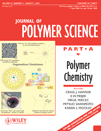Ways of selective polycondensation of L-lysine towards linear α- and ε-poly-L-lysine
Chau Hon Ho
Department of Chemistry, Freiburg Materials Research Center and Institute for Macromolecular Chemistry, Albert-Ludwigs-Universitaet Freiburg, Stefan-Meier-Str. 21, D-79104 Freiburg, Germany
Search for more papers by this authorErich Odermatt
Aesculap AG & Co. KG, Am Aesculap-Platz, D-78532 Tuttlingen, Germany
Search for more papers by this authorIngo Berndt
Aesculap AG & Co. KG, Am Aesculap-Platz, D-78532 Tuttlingen, Germany
Search for more papers by this authorCorresponding Author
Joerg C. Tiller
Department of Bio- and Chemical Engineering, TU Dortmund, Emil-Figge-Str. 66, D-44227 Dortmund, Germany
Department of Bio- and Chemical Engineering, TU Dortmund, Emil-Figge-Str. 66, D-44227 Dortmund, GermanySearch for more papers by this authorChau Hon Ho
Department of Chemistry, Freiburg Materials Research Center and Institute for Macromolecular Chemistry, Albert-Ludwigs-Universitaet Freiburg, Stefan-Meier-Str. 21, D-79104 Freiburg, Germany
Search for more papers by this authorErich Odermatt
Aesculap AG & Co. KG, Am Aesculap-Platz, D-78532 Tuttlingen, Germany
Search for more papers by this authorIngo Berndt
Aesculap AG & Co. KG, Am Aesculap-Platz, D-78532 Tuttlingen, Germany
Search for more papers by this authorCorresponding Author
Joerg C. Tiller
Department of Bio- and Chemical Engineering, TU Dortmund, Emil-Figge-Str. 66, D-44227 Dortmund, Germany
Department of Bio- and Chemical Engineering, TU Dortmund, Emil-Figge-Str. 66, D-44227 Dortmund, GermanySearch for more papers by this authorAbstract
Polylysines (PL) are highly interesting polymers due to their biocompatibility and their high number of reactive amino groups. So far it was not possible to synthesize them directly from L-lysine. Here, we describe two different synthesis routes to selectively polymerize lysine in one batch without the use of protection groups. Applying 1-ethyl-3-(3-dimethylaminopropyl) carbodiimide as activating agent for the polycondensation of L-lysine in water gave selectively linear ε-PLL. In contrast to this, the polymerization of L-lysine in chloroform in the presence of dicyclohexyl carbodiimide and 18-crown-6 ether selectively afforded pure α-PLL. We also assessed the capability of polylysine derivatization by polymer analog reactions with acetic anhydride, methyl iodide and 2,4,6-trinitrobenzenesulfonic acid. © 2008 Wiley Periodicals, Inc. J Polym Sci Part A: Polym Chem 46: 5053–5063, 2008
REFERENCES AND NOTES
- 1 Wagner, E.;Kloeckner, J. Adv Polym Sci 2006, 192, 135–173.
- 2 Lee, M.;Kim, S. W. Polym. Gene Deliv 2005, 79–95.
- 3 Ohsaki, M.;Okuda, T.;Wada, A.;Hirayama, T.;Niidome, T.;Aoyagi, H. Bioconjugate Chem 2002, 13, 510–517.
- 4 Choi, J. S.;Lee, E. J.;Choi, Y. H.;Jeong, Y. J.;Park, J. S. Bioconjugate Chem 1999, 10, 62–65.
- 5 Lochmann, D.;Jauk, E.;Zimmer, A. Eur J Pharm Biopharm 2004, 58, 237–251.
- 6 Brokx, R. D.;Bisland, S. K.;Gariepy, J. J Controlled Release 2002, 78, 115–123.
- 7 Sakthivel, T.;Toth, I.;Florence, A. T. Pharm Res 1998, 15, 776–782.
- 8 Boduch, K. A.;Chapman, T.;Marra, K.;Pettricca, S.;Kumta, P. Polym Prepr (Am Chem Soc, Div Polym Chem) 2002, 43, 520–521.
- 9 Zanini, D.;Roy, R. J Am Chem Soc 1997, 119, 2088–2095.
- 10 Sgouras, D.;Duncan, R. J Mater Sci-Mater Med 1990, 1, 61–68.
- 11 Boas, U.;Heegaard, P. M. H. Chem Soc Rev 2004, 33, 43–63.
- 12 Yoshida, T.;Hiraki, J.;Nagasawa, T. Biopolymers 2003, 7, 107–121.
- 13 Kawasaki, Y.;Hori, M.;Yamamoto, Y.;Hiraki, J. (Ichimaru Pharcos Co., Ltd., Japan; Chisso Corporation). Application: EP, 2005; p 82.
- 14 Philippe, M.;Andrean, H. (L'oreal, Fr.). Application: EP, 2004; p 15.
- 15 Sawai, T.;Arakawa, K.;Hatakeyama, M.;Hiraki, J. (Chisso Corp., Japan). Application: JP, 2004; p 51.
- 16 Rodriguez-Hernandez, J.;Gatti, M.;Klok, H. A. Biomacromolecules 2003, 4, 249–258.
- 17 Deming, T. J. J Polym Sci Part A: Polym Chem 2000, 38, 3011–3018.
- 18 Katchalski, E.;Grossfeld, I.;Frankel, M. J Am Chem Soc 1948, 70, 2094–2101.
- 19
Cattani-Scholz, A.;Renner, C.;Oesterhelt, D.;Moroder, L.
Chembiochem
2001,
2,
542–549.
10.1002/1439-7633(20010803)2:7/8<542::AID-CBIC542>3.0.CO;2-P CAS PubMed Web of Science® Google Scholar
- 20 Denkewalter, R. G.;Kolc, J. F.;Lukasavage, W. J. (Allied Corp., USA). Application: US, 1983; pp 9 Cont -in-part of U.S. 4,360,646.
- 21 Driffield, M.;Goodall, D. M.;Smith, D. K. Org Biomol Chem 2003, 1, 2612–2620.
- 22 Al-Hamra, M.;Ghaddar, T. H. Tetrahedron Lett 2005, 46, 5711–5714.
- 23 Hull, W. E.;Kricheldorf, H. R.;Fehrle, M. Biopolymers 1978, 17, 2427–2443.
- 24 Kricheldorf, H. R.;Fehrle, M. Makromol Chem 1980, 181, 2571–2585.
- 25 Kushwaha, D. R. S.;Mathur, K. B.;Balasubramanian, D. Biopolymers 1980, 19, 219–229.
- 26 Laemmli, U. K. Nature 1970, 227, 680–685.
- 27 Cayot, P.;Tainturier, G. Anal Biochem 1997, 249, 184–200.
- 28 Hennon, G.;Plaquet, R.;Biserte, G. Biochimie 1975, 57, 1395–1396.
- 29 Heinrich, M. R.;Rohlfing, D. L.;Bugna, E. Arch Biochem Biophys 1969, 130, 441–448.
- 30 Scholl, M.;Nguyen, T. Q.;Bruchmann, B.;Klok, H.-A. Macromolecules 2007, 40, 5726–5734.
- 31 Liu, R. H.;Orgel, L. E. Origins Life Evol Biosphere 1998, 28, 47–60.
- 32 Pascual, S.;Haddleton, D. M.;Heywood, D. M.;Khoshdel, E. Eur Polym J 2003, 39, 1559–1565.
- 33 Lanter, C. L.;Guiles, J. W.;Rivero, R. A. Mol Diversity 1998, 4, 149–153.
- 34 Kollen, W. J. W.;Schembri, F. M.;Gerwig, G. J.;Vliegenthart, J. F. G.;Glick, M. C.;Scanlin, T. F. Am J Respir Cell Mol Biol 1999, 20, 1081–1086.
- 35 Huh, K. M.;Ooya, T.;Sasaki, S.;Yui, N. Macromolecules 2001, 34, 2402–2404.
- 36 Williams, A.;Ibrahim, I. T. J Am Chem Soc 1981, 103, 7090–7095.
- 37 Nakajima, N.;Ikada, Y. Bioconjugate Chem 1995, 6, 123–130.
- 38 Ryadnov, M. G.;Klimenko, L. V.;Mitin, Y. V. Russ J Bioorg Chem 1999, 25, 323–328.
- 39 Mascagni, P.;Hyde, C. B.;Charalambous, M. A.;Welham, K. J. J Chem Soc Perkin Trans 1987, 2, 323–327.
- 40 He, X.;Lin, X.;Wang, K.;Chen, L.;Wu, P.;Yuan, Y. Encyclopedia Nanosci Nanotechnol 2004, 1, 235–253.
- 41 Chen, F. C. M.;Benoiton, N. L. Can J Chem 1976, 54, 3310–3311.




